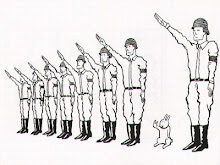Those Irrational Humans
Leon Festinger was a social psychologist from New York City who became famous for his Theory of Cognitive Dissonance, which suggests that inconsistency among beliefs or behaviors will cause an uncomfortable psychological tension thus leading people to change their beliefs to fit their behavior instead of changing the behavior to fit their belief, as conventionally assumed. Dissonance is the uncomfortable feeling or stress caused by holding two contradictory ideas simultaneously and cognition in it's simplest definition is "reality". Festinger's theory arose from his observations of a Wisconsin-based flying saucer cult of the 1950s whose prophecy of universal destruction failed to come true. The cult prophesied a vast flood would soon kill everyone on Earth except for the members of the cult, who would be carried away by flying saucers. Before the predicted flood, the cult was very secretive and very reluctant to speak to the media or make converts. After the predicted flood did not occur, they stopped being secretive and spoke very eagerly to the media. The only way for them to reverse their humiliation was to convert other people to their beliefs.
Festinger claimed that people avoid information that is likely to increase dissonance. Not only do we tend to select reading material and television programs that are consistent with our existing beliefs, we usually choose to be with people who are like us. By taking care to "stick with our own kind," we can maintain the relative comfort of the status quo. Like-minded people buffer us from ideas that could cause discomfort. In that sense, the process of making friends is an example of selecting our own propaganda. People that are like us will keep those things away that make us uncomfortable.
In the late 1950s, Festinger and James Carlsmith recruited Stanford University men to participate in a psychological study. As each man arrived at the lab, he was assigned the boring and repetitive task of sorting a batch of spools into lots of twelve and turning square pegs a quarter turn to the right. The procedure was designed to be both monotonous and tiring. At the end of an hour the experimenter approached the subject and made a request. A student assistant had supposedly failed to show up, and the researcher needed someone to fill in by telling a potential female subject in the waiting room how much fun the experiment was.
Some of the men were promised $1 to express enthusiasm about the task; others were offered $20. It is comforting to know that six of the men refused to take part in the deception, but most students tried to recruit the young woman. What was most interesting was the attitudes after the study was over. Students who lied for $20 confessed that they thought the task of sorting spools was dull. Those who lied for $1 maintained that it was much more enjoyable.
If a student felt qualms about telling a "white lie," the $20 was a ready justification. Thus he felt little or no tension between his action and attitude. But the men who lied for a dollar had lots of cognitive work to do. The logical inconsistency of saying a boring task was interesting had to be explained away through an internal dialogue:
"I’m a Stanford man. Am I the kind of guy who would lie for a dollar? No way. Actually what I told the girl was true. The experiment was a lot of fun."
They changed their attitudes toward the task to bring it into line with their behavior. The Stanford men were in a bind because they regarded themselves as decent, truthful human beings. If they had seen themselves as liars, cheats, or jerks, they would have felt no tension.
University of California social psychologist Elliot Aronson further refined the theory by conducting a controlled experiment showing that people who underwent a tougher initiation have more favorable evaluations of the group they have joined. Aronson concluded that the issue isn’t logical inconsistency, but psychological inconsistency. According to Aronson, the amount of dissonance a person can experience is directly proportional to the effort he or she has invested in the behavior. The harder it is to get into a group, the more an initiate values membership. Rarely does a football player brag that his coach schedules light workouts or that Marine bootcamp was a lark.
No matter how cruel an action, the most common justification is the bully anthem,"he brought it on himself." Everyone likes to think of themselves as good, so when someone deliberately cheats another or marches them to an oven, the other must have deserved it. In the book Mistakes Were Made Carol Tavris and Elliot Aronson explained that contrary to conventional belief that bullies are compensating for low esteem, they actually maintain a high opinion of themselves. "In the horrifying calculus of self-deception, the greater the pain we inflict on others, the greater the need to justify it to maintain our feelings of decency and self worth. Because our victims deserved what they got, we hate them even more than we did before we harmed them, which in turn makes us inflict even more pain on them."


1 Comments:
At 11:22 PM, michael greenwell said…
michael greenwell said…
that was really interesting. thanks.
Post a Comment
<< Home